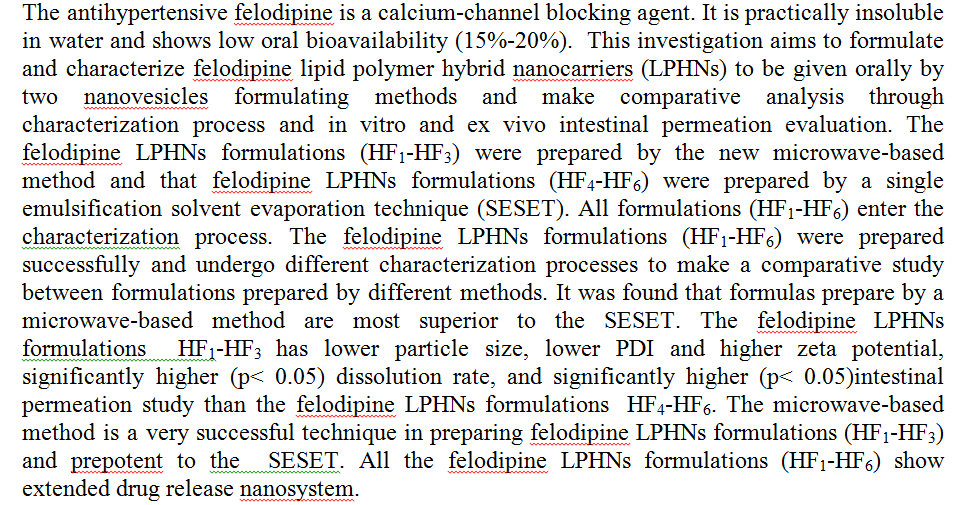A new series polymers was synthesized from reaction starting material Bisacodyl A or [(2-Pyridinylmethylene) di-4, 1-phenylene di acetate] with hydrogen bromide, then the products were polymerized by addition polymerization from used adipoyl and glutaroyl chloride. The structure of these compounds was characterized by FT-IR, melting points, TLC, X-Ray, DSC and 1H-NMR for starting material. These compounds were also screened for their antibacterial activists?
 (1)
(1)
Globally, over forty million people are living with Human Immunodeficiency Viral (HIV) infections. Highly Active Antiretroviral Therapy (HAART) consists of two or three Antiretroviral (ARV) drugs and has been used for more than a decade to prolong the life of AIDS-diagnosed patients. The persistent use of HAART is essential for effectively suppressing HIV replication. Frequent use of multiple medications at relatively high dosages is a major reason for patient noncompliance and an obstacle to achieving efficient pharmacological treatment. Despite strict compliance with the HAART regimen, the eradication of HIV from the host remains unattainable. Anatomical and Intracellular viral reservo
 (2)
(2)
 (2)
(2)
Background: The elimination of the microorganisms from the root canal systems, an important step for the successful root canal treatment. This study was conducted to evaluate the antibacterial effectiveness of the photoactivated disinfection by using the toluidine blue O and a low- energy light emitting diode (LED) lamp . Materials and method: Sixty single rooted extracted teeth were decoronated, instrumented, irrigated, sealed at the apex and contaminated with endodontic anaerobic bacteria for 7 days to form biofilms in prepared root canals. Group I. Twelve teeth were medicated by photosensitizer (toluidine blue O) solution activated by diode lamp (FotoSan; CMS Dental, Copenhagen, Denmark).Group II. Twelve teeth were medicated by the tricr
... Show MoreBackground: Complete removal of filling material from the root canal is an essential requirement for endodontic retreatment. The purpose of the present study is to evaluate and compare the dissolving capabilities of various solvents (Xylene, Eugenate Desobturator, Eucalyptol, EDTA and Distilled water (as a control)) on four different types of sealer (Endofill, Apexit Plus, AH Plus and EndoSequence bioceramic sealer). Materials and method: Eighty samples of each sealer were prepared according to the manufacturers' instructions and then divided into ten groups (of 8 samples) for immersion in the respective solvents for 2 and 5 min immersion periods. Each sealer specimen was weighed to obtain its initial mass. The specimens were immersed in
... Show More (21)
(21)
 (20)
(20)
Objective: Per-implantitis is one of the implant treatment complications. Dentists have failed to restore damaged periodontium by using conventional therapies. Tissue engineering (stem cells, scaffold and growth factors) aims to reconstruct natural tissues. The paper aimed to isolate both periodontal ligament stem cells (PDLSCs) and bone marrow mesenchymal stem cells (BMMSCs) and use them in a co-culture method to create three-layered cell sheets for reconstructing natural periodontal ligament (PDL) tissue. Materials and methods: BMMSCs were isolated from rabbit tibia and femur, and PDLSC culture was established from the lower right incisor. The cells were co-cultured to induce BMMSC differentiation into PDL cells. Cell morphology, stem cel
... Show More (23)
(23)
 (20)
(20)
Background: The majorities of statin-treated patients, in whom low-density lipoprotein cholesterol (LDL-C) targets have been achieved, have had recurrent cardiovascular events (CVE) with an absolute rate remain even higher among patients with disorders of insulin resistance, metabolic syndrome (MetS) and type2 diabetes mellitus (T2DM) as compared to patients devoid of these conditions.Objectives: Provide updated key messages of lipid and lipoprotein abnormalities as indicator for cardiovascular disease (CVD) risk in patients with T2DM and obesity, as well as the current evidence-based treatment targets and interventions to reduce this risk.Key messages: The Residual Risk Reduction Initiative (R3I) emphasized atherogenic dyslipidemia (AD)
... Show MoreAbstract
Binary polymer blend was prepared by mechanical mixing method of unsaturated polyester resin with Nitrile Butadiene Rubber (NBR) with different weight ratios (0, 5, 10 and 15) % of (NBR). Tensile characteristics and wear rates of these blends were studied for all mixing ratios. The microstructure of fracture surfaces of the prepared samples were investigated by optical microscope. The results were showed that strain rates of the resin material increase after blending it with rubber while the ultimate tensile strength and Young’s modulus values of it will decrease. It is also noticed that the wear rate of resin decreases with increasing of (NBR) content.
Keywords:<
... Show More (39)
(39)
 (24)
(24)

